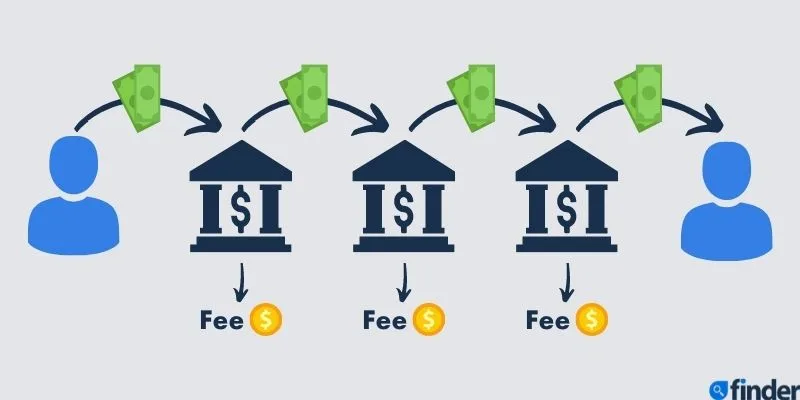When you’re sending or receiving an international money transfer through a bank, you’ll often see the terms like telegraphic transfer, telex transfer, TT or wire transfer. Let’s walk through what these terms mean and how to send money internationally.
What is a telegraphic transfer?
The term telegraphic transfer refers to sending funds electronically and is most commonly used in the UK to refer to what people in Canada and the US would call a bank wire transfer.
Invented in the early 1700s and improved by Samuel Morse (think Morse code) in the mid-1800s, the telegraph is a device that sends interrupted electronic signals across a wire connecting 2 stations.
Nowadays, old-fashioned telegraph devices have been replaced by computers and wireless networks, which transmit funds between accounts using a complex network of intermediary banks and financial institutions.
How does a telegraphic transfer work?
A telegraphic transfer works by bouncing money between a network of banks (called the SWIFT network) until it arrives at its destination.
Money only passes between banks that have pre-existing commercial relationships. Known as “correspondent banks,” these banks usually take a fee to process funds, which may take several days collectively. This is why telegraphic transfers can be slower and more expensive than online money transfer services.
Banks only pass money through other correspondent banks to comply with anti-money laundering laws that require financial institutions to be able to track funds and because it’s not practical to perform money transfers around the world using physical cash.
What is a nostro account?
Nos refers to “we” or “us” in Latin. Nostro accounts are foreign currency accounts that banks hold on behalf of other banks. Other banks refer to accounts held elsewhere as vostro accounts (vos refers to others in Latin).
Banks add and deduct amounts from nostro accounts to track payments sent to and from partner banks. When you send a telegraphic transfer, your money ripples through a series of nostro accounts at different banks until it arrives at its destination.
For straightforward domestic transfers in CAD, there might only be 2 or 3 banks in the network through which funds pass. For payments in US dollars, there are often more banks involved, since USD is a benchmark against which the value of other currencies is determined.

How to make a telegraphic transfer
To make a telegraphic transfer, you need to do the following:
- Go to your local bank’s branch or login to your bank account online or via mobile app.
- Enter the details of your transfer. You’ll need to provide contact information, your recipient’s bank details, the sending and receiving currencies and transfer amount.
- Submit payment. The bank will then process your funds through its network of correspondent banks.
- Verify that funds have been received. Check with your recipient in a few days to make sure your money has arrived. If there’s a problem, you can ask your bank to trace the wire payment, although there may be a fee for doing so.
Telegraphic transfer fees
Telegraphic transfers go through multiple banks, each of which may take a fee. These fees can be broken down as follows:
- Sending bank fees. Your bank will let you know how much these fees are upfront. In Canada, this fee ranges from $15 to $80, depending on the bank.
- Intermediary/corresponding bank fees. Charged by banks in the SWIFT network through which transfers pass en route to your recipient. The exact amount can be hard to determine beforehand.
- Exchange rate margin. Banks and most money transfer services deduct a fee worth a small percentage of the exchange rate. This margin can vary depending on your payment method and currency, but banks tend to deduct a higher percentage that online money transfer services.
- Receiving bank fees. Depending on the bank, your recipient may be charged a fee for receiving a wire transfer.
When initiating a transfer, you’ll often be given the choice of deducting fees from, or paying fees on top of, the amount being sent.
Finder survey: Are Canadians aware of the methods available to send money overseas?
Response | |
|---|---|
| Yes | 58.64% |
| No | 41.36% |
What do you need to make a telegraphic transfer?
To send a telegraphic transfer, you’ll need to provide the following information:
- Your details. This includes your name and bank account details, or the details of anyone on whose behalf you’re sending money.
- Recipient’s details. This includes the recipient’s name, contact information, bank name and address, institution number, transit (or routing) number and account number. Canada doesn’t use IBAN numbers to identify banks, but you may have to provide a SWIFT code. Learn more about the different between IBAN and SWIFT codes here.
- Transfer details. This includes the transfer amount, the reason for the transfer, sending and receiving currencies, the date and any other information the bank requests.
How long do telegraphic transfers take?
Telegraphic transfers can take a number of days. Generally, bank wire transfers from Canada take 3-5 business days.
The exact amount of time varies depending on the banks that are sending and receiving funds, the currencies being exchanged and whether transfers are initiated outside of regular banking hours. Avoid sending just before weekends or on statutory holidays to prevent delays in processing your funds.
Frequently asked questions
More guides on Finder
-
Alternatives to TorFX
Looking for alternatives to TorFX for sending money abroad? Check out these reputable money transfer services.
-
How to pay off an overseas debt
Paying off an overseas debt with an international money transfer can lead to huge savings on fees and interest.
-
How to send money to someone without a bank account
Transfer agents, mobile wallets and online credit card payments don’t necessarily require a bank account.
-
Apps like Remitly
Browse money transfer services like Remitly to see if you can send send money overseas faster and cheaper.
-
10 apps like Venmo in Canada
We compare 10 Venmo alternatives to help you find the mobile payment app that suits you.
-
4 Wise alternatives in Canada
Looking for a money transfer service like Wise? Check out these four Wise alternatives.
-
Best money transfer apps
Fast, affordable, safe and easy to use — these are the best money transfer apps in Canada.
-
Fastest ways to make a money transfer
Learn more about transferring money overseas quickly, easily and safely in an emergency.
-
How long does an international wire transfer take?
Ever wondered how long it takes for an international wire transfer to arrive in your recipient’s bank account? Find out here.
-
What details do I need for an international money transfer?
What bank account details do you need to provide to send or receive an international money transfer? Your guide here.

